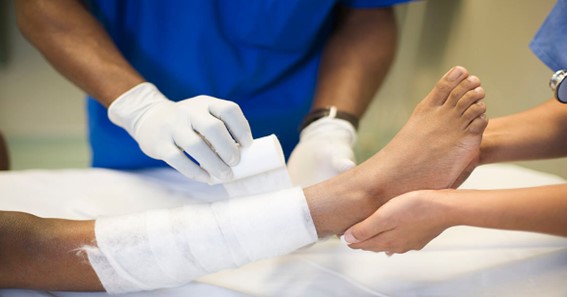Are you curious to know what is occlusive dressing? You have come to the right place as I am going to tell you everything about occlusive dressing in a very simple explanation. Without further discussion let’s begin to know what is occlusive dressing?
In the field of wound care, various types of dressings are utilized to facilitate the healing process and protect the injured area. One such type of dressing that has gained significant recognition is “occlusive dressing.” This specialized wound covering serves a unique purpose and offers distinct advantages in promoting optimal healing for certain types of wounds. In this blog, we will explore what occlusive dressing is, how it works, and its applications in wound care.
What Is Occlusive Dressing?
Occlusive dressing is a type of wound covering that creates an airtight and moisture-resistant seal over the injured area. Unlike traditional dressings that allow air and moisture to pass through, occlusive dressings are impermeable to both, creating a controlled environment around the wound site. This promotes an optimal healing environment by maintaining proper moisture levels and protecting the wound from external contaminants.
How Does Occlusive Dressing Work?
Occlusive dressing works by creating a barrier that covers the wound and the surrounding skin completely. This hermetic seal prevents the entry of external pathogens, such as bacteria and dirt, which can hinder the healing process and lead to infections. Additionally, the dressing locks in the wound’s natural moisture, promoting a moist wound healing environment that has been shown to enhance tissue repair and cell regeneration.
Applications Of Occlusive Dressing
- Superficial Burns: Occlusive dressings are particularly beneficial for superficial burns, as they create an environment that aids in minimizing pain, reducing the risk of infection, and accelerating the healing process.
- Chronic Wounds: Patients with chronic wounds, such as pressure ulcers or diabetic foot ulcers, may benefit from occlusive dressings. These dressings can help maintain the moist environment necessary for the effective healing of such wounds.
- Surgical Incisions: Occlusive dressings are commonly used on post-surgical wounds to provide protection against contamination and promote efficient healing.
- IV Sites: In healthcare settings, occlusive dressings are often used to secure intravenous (IV) catheters and central lines, preventing bacteria from entering the bloodstream through the insertion site.
Benefits Of Occlusive Dressing
- Moist Wound Healing: By maintaining proper moisture levels, occlusive dressings promote an ideal environment for cell migration and tissue regeneration, which accelerates the healing process.
- Infection Prevention: The airtight seal created by occlusive dressings acts as a barrier against external contaminants, significantly reducing the risk of wound infections.
- Reduced Pain: Occlusive dressings can minimize pain and discomfort by shielding the wound from external stimuli and friction.
- Improved Cosmesis: In some cases, occlusive dressings can lead to better cosmetic outcomes, as they keep the wound protected and undisturbed during the healing process.
Conclusion
Occlusive dressing is a valuable tool in wound care, providing a controlled and optimal environment for the healing process to take place. By creating a protective barrier against external contaminants and maintaining proper moisture levels, occlusive dressings significantly reduce the risk of infections and promote faster healing for certain types of wounds. As with any wound dressing, it is essential for healthcare professionals to assess each patient’s unique needs and tailor the wound care plan accordingly. Occlusive dressings, when used appropriately, can play a vital role in enhancing wound healing outcomes and improving patients’ overall well-being.
Get Knowledge About Different Topics On Sizesworld
FAQ
What Are Examples Of Occlusive Dressing?
Occlusive dressings work by maintaining moist wound environment which can shield the wound surface by preventing dry environment and trauma. Dry environment can prevent new epidermal cells migration to the wound surface. Variant types are: 1) semipermeable films, 2) hydrogels, 3) hydrocolloids and 4) alginates.
What Is An Occlusive Wound Dressing?
A dressing is said to be “occlusive” if a moist wound surface is maintained when the dressing is in place. Occlusive dressings prevent wound desiccation by inhibiting the transmission of water vapor from the wound surface to the atmosphere.
What Is The Difference Between Occlusive And Nonocclusive Dressings?
The Meaning of Occlusive and Non-occlusive
Gauze dressings are non-occlusive, meaning they allow air to pass through them onto the dermal surface. On the other hand, occlusive dressings are closed, which means they do not allow air to pass through them.
Is Vaseline Gauze An Occlusive Dressing?
Vaseline® Petrolatum Gauze is a sterile, occlusive dressing consisting of fine-mesh, absorbent gauze impregnated with approximately three times its weight of white petrolatum.
I Have Covered All The Following Queries And Topics In The Above Article
What Is Occlusive Dressing
What Is The Purpose Of A Three-Sided Occlusive Dressing?
What Is A Non Occlusive Dressing
What Is A Non-Occlusive Dressing
What Is Occlusive Dressing Used For
What Is An Occlusive Dressing Used For
What Is A Occlusive Dressing
What Is Occlusive Dressing
What is occlusive dressing?
